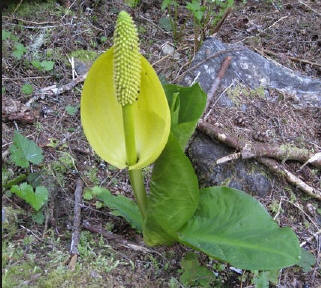(2/17) For many Pennsylvanians, the first sign of spring is the return of the robin, the appearance of snowdrops (flower) or the hopefully last pile of melting snow. However, as these events occur, an overlooked plant blooms. Since it lives in wetlands or in woodlands near streams, it cannot easily be seen by most people; however, it is a native plant that possesses
unique characteristics, worthy of attention and admiration.
 That plant is the Eastern Skunk Cabbage, Symplocarpus foetidus, also known as bear weed, clumpfoot cabbage, hermit of the bog, polecat weed, swamp cabbage and swamp lantern. Its first distinction belongs to its "flowers"; they appear first, but are actually specialized leaves and have an odd shape: bulbous,
rounded, sea shell like, coming to a point at the top, but having a narrow, oblongish opening in the middle. They are brown or maroon with white or yellow patches, frequently blending in with the leaves or shadows on the forest floor. Inside of these leaves, called spathes, the flower itself appears.
That plant is the Eastern Skunk Cabbage, Symplocarpus foetidus, also known as bear weed, clumpfoot cabbage, hermit of the bog, polecat weed, swamp cabbage and swamp lantern. Its first distinction belongs to its "flowers"; they appear first, but are actually specialized leaves and have an odd shape: bulbous,
rounded, sea shell like, coming to a point at the top, but having a narrow, oblongish opening in the middle. They are brown or maroon with white or yellow patches, frequently blending in with the leaves or shadows on the forest floor. Inside of these leaves, called spathes, the flower itself appears.
The next unique trait is the unpleasant odor similar to sulfur or rotten meat, which these flowers emit. This smell travels farther and is stronger, if an accidental injury occurs. The purpose is to attract pollinators, such as beetles and flies, as well as to protect the plant from hungry animals, searching for some fresh vegetation after the barren winter. Also, by
keeping large herbivores (plant eaters) away, the plant protects the soft, wet soil where it grows.
As the spathe begins to end its life cycle, a tightly curled shoot, containing multiple leaves sprouts; it unfurls to become a large round rosette of bright green leaves, up to 1-2 feet in length and a foot in width. If they are injured, they too release a skunk like smell, which attracts pollinators.
However, the most interesting characteristic of this plant is the production of heat. Specifically, it performs thermogenesis and can melt the snow above and around it, so it can emerge from the ground. Furthermore, it controls its own temperature so it is warmer than the air temperature, both during the day or at night. It creates heat through a different respiratory
process than plants normally use, which incorporates mitochondria and fat and resembles animal metabolism.
Despite the word cabbage in its name, this plant is not edible. Its leaves contain crystals of calcium oxalate, which even in small doses pierce the mouth, throat, and digestive tracts and cause painful burning sensations in the mouth and throat, as well as swelling and choking. If large amounts are consumed, oxalates can cause severe breathing difficulties and
digestive upset. Therefore, it is not edible for humans.
However, snapping turtles and black bears, Canada geese and ring-necked pheasants will eat young plants in the spring. Furthermore, the Native Americans prepared different parts of the plant in a variety of ways for medicinal treatments for ailments, such as coughs, earaches, headaches, and sores. In the 1800s, pharmacies sold it as a drug named dracontium to treat
dropsy, nervous disorders, respiratory diseases, and rheumatism.
Skunk cabbage will disappear when the weather becomes hot and dry, usually in the early summer. Since its leaves contain a high water content, they decompose quickly; however, they serve as food for such creatures as caterpillars, isopods, slugs, millipedes and as shelter for small animals. Seeds remain behind, being produced when the plant is five to seven years old.
Although the leaves disappear, the root system remains alive, but dormant. As another distinctive trait, no tap root exists, but many roots form a regular ring shape. They are called contractile roots, since they grow and contract, thereby pulling the stem of the plant deeper into the soil, anchoring it securely. The roots can be as thick as a pencil, grow in all
directions, and do not branch until the root tips where small, fibrous rootlets emerge. Simultaneously, the leaves grow out of the rootstock from a point a few inches in the ground. The age of the plant can loosely be determined by the number of leaves: younger plants have few, while older ones have more. When completely unfurled, these leaves cover large spaces on the
ground. Based on root systems and leaves, theories exist that skunk cabbage can live for hundreds or thousands of years.
While skunk cabbage is a common plant, it is listed as endangered in Tennessee. Furthermore, it does not recover from deforestation or changes in water levels due to development and agriculture. Therefore, it and the wetlands where it lives should be protected for their uniqueness and their ecological roles.